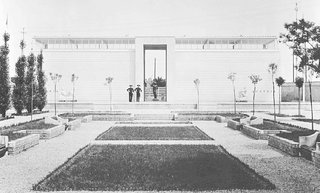Pavilion | Josef HoffmannThe Austrian Pavilion at the Venice Biennale was built in 1934 to a design by Josef Hoffmann (1870-1956), one of the founding members of the Vienna Secession and the Wiener Werkstätte. Of clear, symmetric lines, the building was originally conceived as a kind of "white cube" for painting and graphic art. The pavilion became Joseph Hoffman's last building to gain international recognition. As early as 1910, Josef Hoffmann was responsible for exhibition architecture design at the Biennale. In the absence of an Austrian pavilion – in 1909, Hungarian, Bohemian, and Moravian provinces of the Habsburg Monarchy had already erected individual national pavilions – an Italian panel had invited Gustav Klimt for a retrospective at the international pavilion. At the time, Gustav Klimt's exhibition in the design by Josef Hoffmann attracted considerable international attention. After the „Anschluss", Austria's annexation by the Third Reich in 1938, and during subsequent Biennale years 1940 and 1942, the Austrian pavilion remained unused. Austrian artists recognised by the NS-regime were exhibited at the German pavilion instead. After the war (from 1948 to 1956), Josef Hoffmann acted as commissioner for the Austrian contributions to the Venice Biennale, which from 1948 onward, once again took place at the Austrian pavilion. In the course of its history, the pavilion was altered several times. In 1984, on the occasion of the 50th anniversary of its erection, it underwent a comprehensive restoration by Hans Hollein, which restored the rooms' original dimensions and the previous situation of the entrance. |
Pavilion:
Josef
Hoffmann
Josef
Hoffmann


